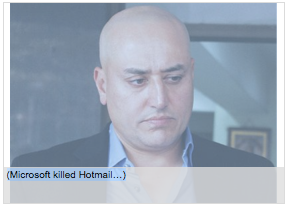Atanu Chakrabarti got his Hotmail
id back in 1999. As he was signing up for the free email service, which
was quite the rage back then, Chakrabarti discovered that the ID with
his name had already been taken. Instead, the site threw up an alternate
ID: "atanu60."x
Sixty was neither Chakrabarti's age nor his year
of birth, just a random number thrown up by the website. Still raw to
the world of email, like most Indians were, Chakrabarti signed up for
that "goofy id" and stayed loyal to Hotmail for a long time. Today,
Hotmail isn't Chakrabarti's primary or secondary email id. Gmail and Yahoo mail take care of that.
It's a story that many people in India, perhaps even across the world,
will tell you: of how Hotmail was their personal email id of choice for a
long time before the likes of Gmail came along.
To be sure,
Hotmail still is the world's largest email service provider with just
over 325 million users worldwide. But that lead is shrinking with
upstart Gmail notching up 298.2 million users and old foe Yahoo Mail
still chugging along 298 million users, according tracking firm comScore.
That's probably one reason why Microsoft
chose to bid adieu to the Hotmail brand and wipe the slate clean and
start afresh with Outlook, what Microsoft calls as "modern email for the
next billion mailboxes". So, how did Microsoft and Hotmail lose its
edge in the battle of the inbox?
Freemail and Flowers
Back in November 1995, Bill Gates' book The Road Ahead was published
with no mention of the word internet in it, recalls Bangalore-based
technologist Atul Chitnis. A significantly fatter edition with a special
focus on the internet was released the next year.
"Earlier that
year [1995], Microsoft had released Windows 95 without internet
support," says Chitnis. The point Chitnis is making is that Microsoft
did not have a clear-cut internet strategy in the mid-90s.
But
when the Redmond giant decided to play the internet game, it chose do so
in a big way: a slew of acquisitions. Hotmail was Microsoft's largest
acquisition for a long time. In the last days of 1997, the company
signed a deal with Hotmail for an estimated $400 million.
It was a
heady time. The dotcom boom was, well, booming. Everybody was talking
about "capturing eyeballs". The idea was to drive traffic to websites, which would then translate to advertising and e-commerce revenues. And what better way to do this than buy into a free email service
(popularly known as freemail) with its millions of users? Hotmail
launched its freemail services on July 4, 1996. By the end of 1997,
Hotmail had over 9 million users.
Around this time, Microsoft was
cobbling together an internet strategy which involved driving traffic
to sites like msn.com and travel portal Expedia (which it spun off and
exited later). The competition was already awake to the opportunity. In
October 1997, Yahoo bought a company called Four11, which offered a
product called Rocketmail (later became Yahoo mail). Companies like Lycos and Excite were also offering mail services.
Microsoft had snapped up Hotmail hoping that its 9 million user base
would boost the traffic flow to MSN and its other internet operations
and that would lead to more e-commerce revenues.
"We can offer our subscribers music, books, software, flowers and investment advice," Hotmail founder Sabeer Bhatia
had told Businessweek, commenting on the synergies between Hotmail and
MSN soon after the acquisition. So, who cared if Hotmail's revenues were
just over $4 million in its first year of operations?
Growth and Gmail
That deal, however, made Sabeer Bhatia India's hero. "We needed heroes
back then. It was like Bindra's Olympic gold moment for us back then,"
says Chitnis, only half in jest. "The fact that he sold Hotmail to
Microsoft for $400 million made it an even bigger deal." To put that in
perspective, in March 1998, Infosys reported revenues of just $ 68.33
million and employed just over 2,600 people.
Hotmail continued to
grow under Microsoft. By 2005, Hotmail had over 200 million users. But
people began to complain about increasing spam filling their inboxes.
"Hotmail had security issues a few years ago, which made it extremely
hackable. Getting an email from a friend's hotmail ID claiming that he
was stuck in Kinshasa and urgently needed $1,000 was a common
occurrence," says Nakul Shenoy, a usability research expert, who had
signed onto Hotmail largely to access its messenger chat services in the
late '90s. The fact that Hotmail IDs became inactive if not accessed
for a few months also was an irritant, says Shenoy.
And then in
2004 came Gmail. With it's "unlimited storage", "clean, professional"
interface and of course social media adaptability, Hotmail came across
like a relic from the dial-up days. Even the Hotmail brand which once
was the epitome of cool began to sound a little less snazzy.
In
that sense, Microsoft is doing the right thing: a whole rewrite of the
email service instead of the cosmetic touch-ups it had been doing for
nearly a decade. Whether that will be enough to put distance between the
competition snapping at its heels will be something only time will
tell.












